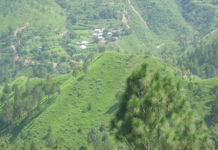By Muhammad Luqman
With per capita water availability coming down to 900 cubic meters from 5000 cubic meters over the last seven decades, Pakistan is about to enter the club of the water-deficient nations. Low rainfall , lowering aquifers and decrease in the inflow of waters in rivers are billed responsible for the stress on Pakistan’s water resources. With groundwater level drifting below 200 feet, the scenario is getting alarming for agriculture as well as human population. The situation has affected most of the South Asian country especially its central province of Punjab , considered the grain-bowl. To mitigate the water crisis, the government of Punjab province has introduced incentives for the promotion of water conservation schemes like drip and sprinkler modes of irrigation.
In drip irrigation, the water is released in drops through a pipeline for almost every plant in the field, minimizing the chances of any major loss.
“Farmers have adopted drip irrigation technology over 37,000 acres of land in Punjab, mostly for value-added crops like vegetables,” says Aamir Mushtaq, a water management specialist.
He admits that it is very small area when compared to a total of 3.5 million acres of agriculture land, yet it is still a good beginning .
Before the introduction of the conservation irrigation, flooding of the fields of major crops especially paddy by the farmers was very common practice. “ How much water intensive paddy is; Production of one kilogram of Basmati rice involves consumption of atleast 3000 litres of water,” says Dr. Muhammad Akhtar, Director Rice Research Institute (RRI), Kala Shah Kaku, Pakistan.
Drip irrigation has also been introduced for the major crops like Maize in Punjab province. However, the adoption of the technology in traditional crops is very slow.
“ To encourage the farmers, government is sharing 60 percent of the cost of the drip irrigation system and 80 percent for the solar submersible tubewells,” Muhammad Imran, Punjab Agriculture department official says.
According to Food and Agriculture Organization (FAO) report, solar powered irrigation systems are now an affordable and climate-friendly technology for both large and small-scale farmers in developing countries including Pakistan.
Sharp and ongoing drops in the price of photovoltaic panels give new impetus to the renewable energy source as a way to enhance irrigation capacity.
“The rapid expansion of more affordable solar-powered irrigation offers viable solutions that span the water-energy-food nexus, providing a great opportunity for small-holders to improve their livelihoods, economic prosperity and food security,” the report said.
Globally, about 20 percent of cultivated land is irrigated, and they contribute to about 40 percent of total food output.
Irrigation boosts agricultural productivity in various ways, including by allowing more and varied crops per year. Sub-Saharan Africa and Latin America have relatively low deployment of irrigation on croplands, indicating sizeable potential gains there.
Solar powered irrigations systems indicate the potential to reduce GHG emissions per unit of energy used for water pumping by more than 95 percent compared to alternatives fuelled by diesel or fossil-fuel driven electricity grids, according to FAO’s report.















